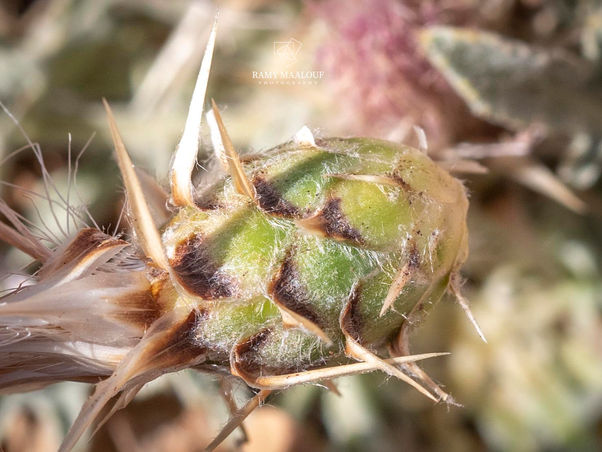Family |
Asteraceae
Myopordon pulchellum
(C.Winkl. & Barbey) Wagenitz

Endemic to Lebanon
Myopordon pulchellum (C.Winkl. & Barbey) Wagenitz
(First published in Ber. Deutsch. Bot. Ges. 71: 276; 1958. Treated in Nouvelle Flore du Liban et de la Syrie, vol. 3, p. 465, Pl. CCLXXVII nº 1; 1984, as Autrania pulchella Winkl. & Barbey)
• Life-form & habit: Subacaulescent monocarpic perennial, 3 – 5 cm tall, arising from a thick rhizome, forming a dense rosette.
• Leaves: All basal, shortly petiolate with sheathing bases, ovate-lanceolate, pinnatifid or lyrate, both surfaces canescent, margins ciliate-dentate; lobes ovate, tipped with a short spine.
• Inflorescence & flowers: Capitulum solitary, sessile, as large or larger than the rosette. Involucral bracts arachnoid-canescent, ending in a strong semilunar dark appendage, acuminate into a spine (≥10 mm). Receptacle with smooth hairs twisted at the base. Florets purplish.
• Fruit: Achenes 5 × 1 mm, nearly smooth, with lateral hilum; pappus of unequal white bristles.
• Phenology: July – September.
• Habitat & elevation: Alpine rocky slopes and ridges, 2 500 – 3 000 m.
• Lebanese distribution: Qornet es-Saouda and surrounding ridges, Dahr el-Kodib, Col des Cèdres, Makmel summits, Rijal el-‘Achara, Jourd Qarassia.
• Native range: Endemic to Lebanon.
• Conservation notes: A strict alpine endemic, restricted to the highest summits of northern Mount Lebanon.
• ⚠️ Taxonomic note: First described as Autrania pulchella by Winkler & Barbey; later transferred to Myopordon by Wagenitz. Distinguished from M. thiebauti by its long-spined, semilunar appendages on involucral bracts and pinnatifid leaves.






